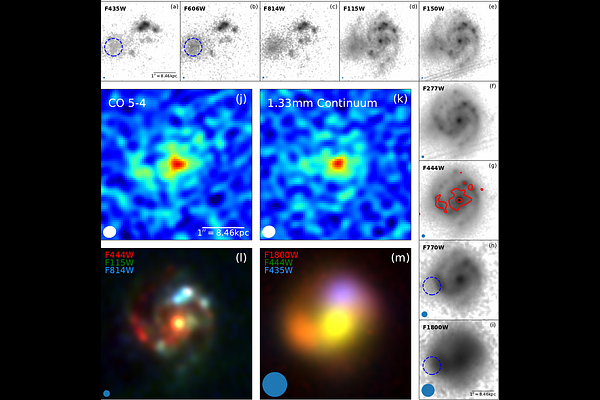A PAH deficit in the starburst core of a distant spiral galaxy

A PAH deficit in the starburst core of a distant spiral galaxy
Zhaoxuan Liu, John D. Silverman, Emanuele Daddi, Boris S. Kalita, Annagrazia Puglisi, Qinyue Fei, Alvio Renzini, Daichi Kashino, Francesco Valentino, Jeyhan S. Kartaltepe, Daizhong Liu, Pablo G. Pérez-González, Jed McKinney, Caitlin M. Casey, Xuheng Ding, Andreas Faisst, Maximilien Franco, Darshan Kakkad, Anton M. Koekemoer, Erini Lambrides, Steven Gillman, Ghassem Gozaliasl, Henry Joy McCracken, Jason Rhodes, Brant E. Robertson, Giulia Rodighiero, Wiphu Rujopakarn, Tomoko L. Suzuki, Takumi S. Tanaka, Brittany N. Vanderhoof, Aswin P. Vijayan, Olivia R. Cooper, Aidan Kaminsky, Georgios E. Magdis, Namrata Roy
AbstractWe present high-resolution and spatially-matched observations with JWST and ALMA of a starburst galaxy (PACS-830) at $z=1.46$. The NIRCam observations mainly trace the stellar light while the CO ($J$=5--4) observations map the dense molecular gas at kpc scales. Both datasets reveal the morphology to be that of a gas/dust rich bulge with two extending arms, together resembling a grand-design spiral galaxy. The more pronounced arm contributes 21 $\pm$ 6\% of the total CO emission. These results demonstrate that starburst activity at high redshift can be triggered, without undergoing a highly disruptive major merger. We assess the strength and distribution of star formation using two tracers: (1) Polycyclic Aromatic Hydrocarbons (PAHs) emission detected at $8~\mu$m ($L_8$) with a MIRI/F1800W image, and (2) $L_\mathrm{IR}$, inferred from the CO ($J$=5--4) map. The spatial profiles of the $L_\mathrm{IR}$ and $L_8$ are dissimilar, thus leading to a significant deficit of mid-IR ($L_8$) emission in the nucleus. We hypothesize that this is due to the destruction of PAH molecules by the intense ionizing radiation field or decreased emission in the photodissociation region, as seen in nearby star-forming regions and consistent with the galaxy-wide properties of distant starbursts. This study reveals spatial variations in the $L_8$ to $L_\mathrm{IR}$ ratio for the first time at $z>1$, in agreement with expectations from theory. Our analysis underscores the pivotal role of joint high-resolution observations with JWST and ALMA in discerning the different phases of the interstellar medium (ISM) and revealing internal physics in galaxy substructures.